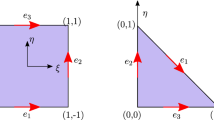Abstract:
Although the primitive (P), diamond (D) and gyroid (G) minimal surfaces form the structural basis for a multitude of self-assembling phases, such as the bicontinuous cubics, relatively little is known regarding their geometrical transformations, beyond the existence of the Bonnet isometry. Here their highest symmetry deformation modes, the rhombohedral and tetragonal distortions, are fully elucidated to provide a unified description of these simplest minimal surface families, with all quantities expressed in terms of complete elliptic integrals. The rhombohedral distortions of the gyroid are found to merge continuously with those which bridge the P and D surfaces, furnishing direct transformations between all three cubics, preserving both topology and zero mean curvature throughout. The tetragonal distortions behave analogously, offering an alternative route from the gyroid to the D surface. The cell axis ratios, surface areas and Gaussian curvature moments of all families are given, supplying the necessary geometrical input to a curvature energy description of cubic and intermediate phase stability.
Similar content being viewed by others
Author information
Authors and Affiliations
Additional information
Received: 5 March 1998 / Revised: 29 July 1998 / Accepted: 31 July 1998
Rights and permissions
About this article
Cite this article
Fogden, A., Hyde, S. Continuous transformations of cubic minimal surfaces. Eur. Phys. J. B 7, 91–104 (1999). https://doi.org/10.1007/s100510050592
Issue Date:
DOI: https://doi.org/10.1007/s100510050592




